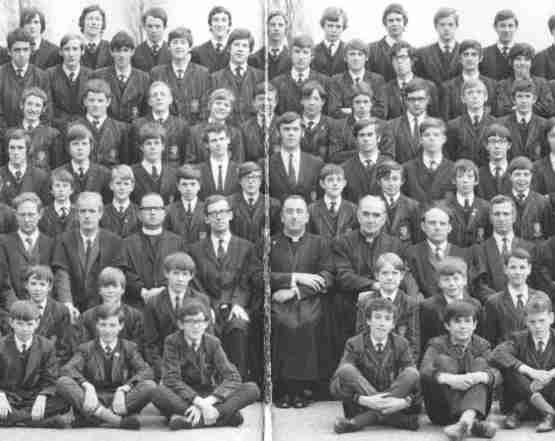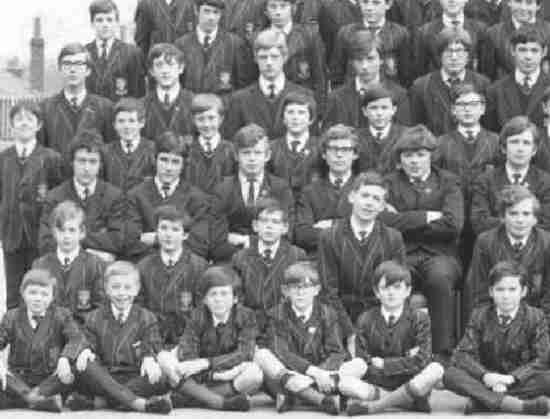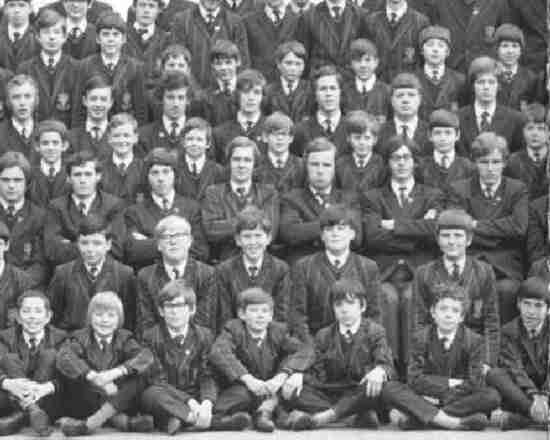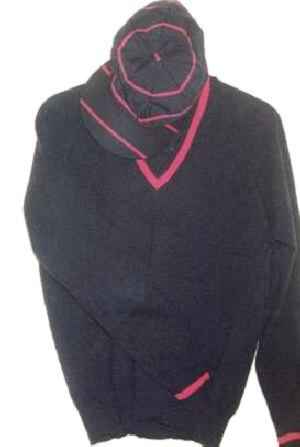
Figure 1.--St. Augustine had a destinctive stripped blazer. Almost all of the boys at St. Augustine Boys' Grammar in 1971 wore long trousers--even the younger boys.


Figure 1.--St. Augustine had a destinctive stripped blazer. Almost all of the boys at St. Augustine Boys' Grammar in 1971 wore long trousers--even the younger boys. |
St. Augustine is a Catholic boys' grammar school located near Manchester. It is a relatively new school, opened in 1965-69. Most grammar schools were single gender schools. The uniform at St. Augustine's was the standard blazer, tie, and grey trousers. A fwe younger boys wore caps and short trousers, but neither were required.
St. Augustine's Grammar School is a Catholic school dedicated to St. Augustine of Canterbury, the great missionary who came to England in the reign of Pope Gregory the Great. Augustine was not the first missionary to come to Britain. He may be said to have revived Christianity, after the coming of the pagan Angles and Saxons. Formerly the Prior of the monastery of St. Andrew on the Coelian Hill in Rome, he arrived in England in 597 and established his see at Canterbury, at the invitation of Ethelbert, King of Kent. The school’s coat of arms commemorates Augustine and the see of Canterbury which he founded.
St. Augustine's was a relatively new grammar school it was opened in 1965 as a Grammar Technical School in 1965 and was restablished a a Grammar School in 1969. The photographs used here are from 1971, only a few years after the school was established and reorganized as a Grammar School.

Figure 2.--The school uniform was a dark navy blazer with thin magenta. Only a few of the younger boys in 1971 wore short trousers and kneesocks, but there was no school rule requiring shorts. |
The boys in the photograph are all very smartly turned out. Yje school clearly believed in the value of school uniform. The school clearly required blazers and ties and enforced the rules. As the school was founde only in the late 1960s, caps were not required. While there was an official cap, it was not widely worn. Nor were boys required to wear short trousers. It was common in the 1060s at many grammar schools to require juniir boys to wear shorts. This was often the case at the older more established schools. While optional, a few boys did wear them in 1971. Probably because their parents thought that they were appropriate schoolwear for younger boys. At many grammar schools by the 1970s, shorts has disappeared completely.
Wearing the school uniform was compulsory, it was at most grammar schools. Boys who arrived without a tie would result in the pupil being sent home immediately to fetch it regardless of distance. Some boys might first be saved by the school office with the loan of a spare one. The headmaster organised a catwalk of two pupils for the parents of prospective first years, the first wearing an immaculately pressed school uniform, the second wearing an old dirty anorak. The parents
were then asked which boy's appearance they preferred!

Figure 3.--The school uniform was a dark blazer than thin stripes. Only a few of the younger boys in 1971 wore short trousers and kneesocks, suggesting that it was no longer a school rule. |
Boys were required to have Haircut was short. any pupil arriving with hair longer than that which the headmaster regarded
appropriate would be dispatched forthwith to the local barber with a loan from the school to pay the bill! Boys by the 1970s were wearing their hair muvch longer than earlier--even some of the masters. None of the boys, however, had really long hair. The school web site reports that the memory of short hair cuts "... is unsubstantiated by sixth form photos--maybe tolerance had increased by then."
Some basic information is available on the uniform the boys wore.
The boys for their school picture of course did not wear their caps. The school had a blue cap with magenta circles. THe school did have a cap. It was a traditional peaked cap, navy with magenta circles. The school Web sitte says that it was optional (very! but useful for
goalposts!). A school cap was compulsory for younger boys at many grammar schools, but many schools dispensed with caps during the 1970s.

Figure 4.--This image shows the navy blue jumper and cap with the magenta trim and circles. The cap was not commonly worn.. |
All the boys wear the school blazer. The blazer was dark blue with magenta stripes. The destinctive blazer earned the the pupils the nickname "pyjama boys". Magenta was the (tie) colour at Rt Rev Msg McGuiness's former College at Cambridge--Downing, hence its inclusion in this uniformThe stripy blazer was discontinued in 1978. The older 6th form blazer was plain navy.
The school tie was require wear. It was navy with diagonal magenta and white stripes
Grammar schools liked to follow the model of England'd prestigious public (exclusive private) schools. Thus many wore the school scarfe. It was navy with tranverse magenta stripes. The
6th form scarf had longitudinal stripes of navy magenta and white
(narrow).
The boys have their blazers buttones, perhaps it was a school rule. As a result it is difficult to see if they are wearing jumpers. One You can see at least one boy's jumper (figure 1). He wears the pullover jumper. It was a navy V neck with the neckline and cuffs outlined in magenta, matching the blazer.
Most of the boys wear long dark grey trousers. A few of the younger boys wear short trousers. It was common for English grammar schools to require boys in the younger forms to wear short trousers. This was especially the case at the older, more traditional schools. Only a small number of boys at St. Augustine Boys' Grammar in 1971 were wearing shorts. This would mean that only a few of the Form 1 boys were wearing shorts. Shorts were an optional item left to the parent's disgression. The boys soon made up their own minds. The school web site explains, "First years soon realised the former was desirable."
All of the boys in shorts wore kneesocks. Presumably this was a school rule or the boys may have all worn kneesocks because there parents thought it important to wear the school socks. The boys appear to be wearing grey kneesocks with colored bands at the top in the school colors--presumably the samne color as the blazer.
The school gaberine raincoat was compulsory between the declaration of winter and the declaration of summer (then only necessary on days of inclement weather). About 1994, the Crombie overcoat became an officially recognised alternative despite being the uniform of another 'organisation' at that time. This was as a result of advice by the "School Council". The headmaster in 1977 sent a letter hom stressin the need to wear the school uniform, including the rain coat.
Related Chronolgy Pages in the Boys' Historical Web Site
[The 1880s]
[The 1930s]
[The 1940s]
[The 1950s]
[The 1960s]
[The 1970s]
[The 1980s]
Related Style Pages in the Boys' Historical Web Site
[Long pants suits]
[Short pants suits]
[Socks]
[Eton suits]
[Jacket and trousers]
[Blazer]
[School sandals]
